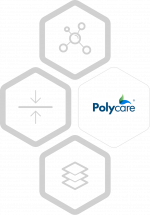Making the best waste bags requires expertise, experience and an unwavering commitment to quality. Starting from a deep understanding of users’ needs we leverage our knowledge of polythene manufacturing and global supply chains to deliver the bags you need at price points you can afford.

Polythene Technology
Advanced Manufacturing & Innovation
Our R&D teams are always working on developing new blends to achieve the most robust product quality while optimising raw material use. The development of advanced resins and additives allows manufacturers to design thinner, lighter waste bags that are stronger and more durable than thicker bags made from lower quality raw materials.

More than the sum of…
Extrusion / Blend / Thickness
Quality and strength of the bags are not solely dependent on the micron (thickness) of the bag. When engineering Polycare bags and aprons we combine our industry leading blend and extrusion technology to ensure quantity and strength while reducing material required. This ensures cost savings and better sustainability while still providing the strongest and highest quality bags and aprons.
We often get samples made in a mixture of blends to get an idea of what will work for that particular bag, this gives us great insight to what the strength and quality will be like. We aim to provide the best bags that we can, while still being competitive. This does also involve speaking to our factory’s who can suggest different variations on the micron and blend.

The bags we produce also vary based on its intended use. For example we produce domestic waste bags two of which are some of our biggest sellers, (BVDP28 and BVDP28L) that are 100% recycled bags. The reason for this is that the bags are taking general waste products and does not need to contain any HDPE or LDPE for strength. The benefit of this is that the bags are cheaper and are using 100% recycled material which is better for the environment/wastage.

Then on the other side we have our clinical bags most of which are 80% HDPE and 20% Recycled. This is the formula that’s used for most as it offers great strength which is needed for our clinical bags as they have to undergo a series of tests in order to gain its certificate. There are some bags such as MVN455 that are 100% HDPE Virgin, this gives the bags even more strength.

















